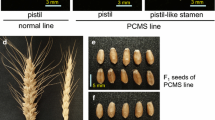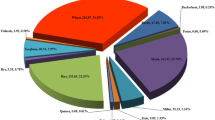Summary
The gametocidal effects of RH-531, RH-532, and RH-2956 were studied with three rates and times of foliar application on two spring wheat (Triticum aestivum L.) varieties, Anza and Yecora 70. RH-531 and RH-532 applied at or before booting stage caused rather large reduction in plant height while RH-2956 had a small effect on height. Application of any of the three chemicals on ‘Anza’ at meiotic stages reduced self-pollination (SP) fertility by 97–99%. If 90% SP fertility reduction is acceptable, the application time could vary from premeiosis to postmeiosis for ‘Anza’. ‘Yecora 70’ was less sensitive than ‘Anza’ to gametocide treatments. The lowest SP fertility obtained in ‘Yecora 70’ with RH-531, RH-532, and RH-2956 was by treatment at booting (4 kg/ha), at premeiosis (2 kg/ha), and heading (8 kg/ha), and the corresponding SP fertility reductions were 74, 89, and 71%. Pollen stainability-determined by aceto-carmine, IKI, and Alexander's stains-was not affected by gametocide treatment and was not useful in evaluating sterility induced by these chemicals. For the RH-531-treated ‘Anza’ and ‘Yecora 70’ and the RH-532-treated ‘Anza’, more than 94% of the seeds produced by open-pollination on treated plants were from self-or sib-pollination as determined by progeny testing. However, RH-532-treated ‘Yecora 70’ and RH-2956-treated ‘Anza’ and ‘Yecora 70’ did result in more crossed seeds, with a maximum of 20% outcrossing. It was believed that spike compactness induced by the chemicals and the related poor flower opening were the major limitations for outcrossing. Artificial pollinations made to the test varieties showed that RH-531 induced both male and female sterility and was undesirable for practical use. RH-532, however, could be applied at the booting stage to avoid severe female sterility, and RH-2956 clearly was the best of the three chemicals, with the female fertility very close to those of the untreated checks of both ‘Anza’ and ‘Yecora 70’. Of the three chemicals, RH-2956 gave the highest percentage of hybrid plants in the progeny of hand-or open-pollinated spikes. Its practical use for hybrid seed production, however, will depend largely on improvement of methods to increase cross pollination in wheat.
Similar content being viewed by others
References
Alexander, M. P., 1969. Differential staining of aborted and non-aborted pollen. Stain Technol. 44: 117–122.
Basilis, Borghi, F. Bonali & G. Boggini, 1973. Induction of male sterility in wheat with ethephon for hybrid seed production. Proc. 4th int. Wheat Genetics Symp, (Columbia, Missouri, USA), pp. 337–343.
Brown, C. M. & E. B. Earley, 1973. Response of one winter wheat and two spring oat varieties to foliar applications of 2-chloroethylphosphonic acid (Ethrel). Agron. J. 65: 829–832.
De Vries, A. Ph., 1972. Some aspects of cross-pollination in wheat (Triticum aestivum L.) 1. Pollen concentration in the field as influenced by variety, diurnal pattern, weather conditions and level as compared to the height of the pollen donor. Euphytica 21: 185–203.
De Vries, A. Ph., 1973. Some aspects of cross-pollination in wheat (Triticum aestivum L.) 2. Anther extrusion and ear and plant flowering pattern and duration. Euphytica 2: 445–456.
De Vries, A. Ph., 1974. Some aspects of cross-pollination in wheat (Triticum aestivum L.) 3. Anther length and number of pollen grains per anther. Euphytica 23: 11–19.
Jan, C. C., 1974. Genetic male sterility in wheat (Triticum aestivum L.): expression, stability, inheritance, and practical use. Ph. D. Dissertation, University of California, Davis, CA, USA.
Jan, C. C., C. O. Qualset & H. E. Vogt, 1974. Chemical induction of sterility in wheat. Euphytica 23: 78–85.
Law, J. & N. C. Stoskopf, 1973. Further observations on ethephon (Ethrel) as a tool for developing hybrid cereals. Can J. Plant Sci. 53: 765–766.
Rowell, P. L. & D. G. Miller, 1971. Induction of male sterility in wheat with 2-chloroethylphosphonic acid (Ethrel). Crop Sci. 11: 629–631.
Rowell, P. G. & D. G. Miller, 1974. Effect of 2-chloroethylphosphonic acid (ethephon) on female fertility of two wheat varieties. Crop Sci. 14: 31–34.
Stoskopf, N. C. & J. Law, 1972. Some observations on Ethrel as a tool for developing hybrid cereals. Can. J. Plant Sci. 52: 680–683.
Wang, R. C., 1971. M. S. Thesis, Rutgers University (cited by Yih et al., 1971).
Yih, R. Y., P. J. McNulty, M. C. Swidel & K. L. Viste, 1971. Plant growth regulating properties of 3-carboxy-2-pyridones. Hort. Sci. 6: 460–461.
Author information
Authors and Affiliations
Rights and permissions
About this article
Cite this article
Jan, C.C., Qualset, C.O. & Vogt, H.E. Chemically induced sterility in wheat for hybrid seed production. Euphytica 25, 375–386 (1976). https://doi.org/10.1007/BF00041570
Received:
Issue Date:
DOI: https://doi.org/10.1007/BF00041570




